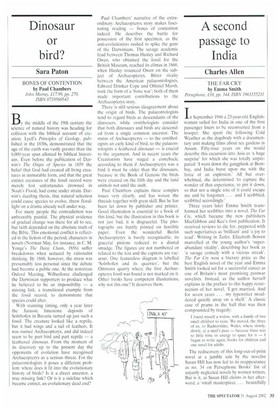Dinosaur or bird?
Sara Paton
BONES OF CONTENTION by Paul Chambers John Murray, £17.99, pp. 270, ISBN 0719560543 By the middle of the 19th century the science of natural history was heading for collision with the biblical account of creation. Lye11's Principles of Geology, published in the 1830s, demonstrated that the age of the earth was vastly greater than the 6,000-year span allotted by biblical historians. Even before the publication of Darwin's The Origin of Species in 1859 the belief that God had created all living creatures in immutable form, and that the great extinct creatures of the fossil record were merely lost unfortunates drowned in Noah's Flood, had come under strain. Darwin's dazzling thesis, that natural selection could cause species to evolve, threw floodlight on a drama already well under way.
For many people the contradiction was unbearably painful. The physical evidence of gradual change was there for all to see, but faith depended on the absolute truth of the Bible. This emotional conflict is reflected in the fiction of the period; characters in novels (Norman May, for instance, in C. M. Yonge's The Daisy Chain, 1856) suffer breakdowns when seduced by rationalist thinking. By 1860, however, the stress was presumably less personal since the debate had become a public one. At the notorious Oxford Meeting, Wilberforce challenged the Darwinian supporters to produce what he believed to be an impossibility — a missing link, a transitional example from the fossil record, to demonstrate that species could alter.
With stunning timing, only a year later the Jurassic limestone deposits of Solnhofen in Bavaria turned up just such a fossil. The creature looked like a reptile, but it had wings and a tail of feathers. It was named Archaeopteryx, and did indeed seem to be part bird and part reptile — a feathered dinosaur. From the moment of its discovery up to the present day the opponents of evolution have recognised Archaeopteryx as a serious threat. For the palaeontologists it poses a different problem: where does it fit into the evolutionary history of birds? Is it a direct ancestor, a true missing link? Or is it a sideline which became extinct, an evolutionary dead end? Paul Chambers' narrative of the extraordinary Archaeopteryx story makes fascinating reading — bones of contention indeed. He describes the battle for possession of the first specimen, as the anti-evolutionists rushed to spike the guns of the Darwinians. The savage academic feud between Thomas Huxley and Richard Owen, who obtained the fossil for the British Museum, reached its climax in 1868, when Huxley trounced Owen on the subject of Archaeopteryx. Bitter rivalry between the American palaeontologists, Edward Drinker Cope and Othniel Marsh, took the form of a 'bone war'; both of them made important contributions to the Archaeopteryx story.
There is still serious disagreement about the origin of birds. The palaeontologists tend to regard birds as descendants of the dinosaurs, while ornithologists consider that both dinosaurs and birds are descended from a single common ancestor. The status of Archaeopteryx — to the ornithologists an early kind of bird, to the palaeontologists a feathered dinosaur — is crucial to the argument. And in recent years the Creationists have staged a comeback; according to them if Archaeopteryx was a bird it must be older than the dinosaurs, because in the Book of Genesis the birds were created on the fifth day and the land animals not until the sixth.
Paul Chambers explains these complex issues very clearly, and has woven the threads together with great skill. But he has been let down by publisher and printer. Good illustration is essential to a book of this kind, but the illustration in this book is not just bad, it is disgraceful. The photographs are fuzzily printed on horrible paper. Even the wonderful Berlin Archaeopteryx is barely recognisable, its graceful pinions reduced to a dismal smudge. The figures are not numbered or related to the text and the captions are vacuous. One featureless diagram is labelled `Solnhofen and its quarries', but the Ottmann quarry where the first Archaeopteryx fossil was found is not marked on it. Other books have competent illustrations, why not this one? It deserves them.


























































 Previous page
Previous page